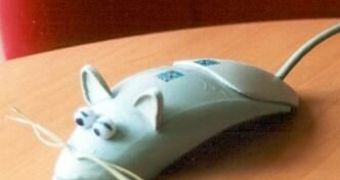The mouse, a computer peripheral that probably doesn't save your life, but it sure makes it a lot easier, has evolved over the years, much like its biological counterpart, adapting itself (well, humans did the adapting for it, actually) to new "environmental" conditions.
It's the survival of the fittest, a principle as valid in the silicon world as it is in nature.
The name mouse, coined at the Stanford Research Institute, derives from the resemblance of early models (which had a cord attached to the rear part of the device, suggesting the idea of a tail) to the common eponymous rodent, and it remained unchanged in most languages, proof of information globalization.
Douglas Engelbart of the Stanford Research Institute invented the mouse in 1964 after extensive usability testing. Several other experimental pointing-devices developed for Engelbart's oN-Line System (NLS) exploited different body movements - for example, head-mounted devices attached to the chin or nose - but ultimately the mouse won out because of its simplicity and convenience.
The first mouse, a bulky device, used two gear-wheels perpendicular to each other: the rotation of each wheel translated into motion along one axis. Engelbart received patent US3541541 on November 17, 1970 for an "X-Y Position Indicator for a Display System". At the time, Engelbart envisaged that users would hold the mouse continuously in one hand and type on a five-key chord keyset with the other.
It appears that the venerable wheeled mouse is in danger of extinction. The now-preferred device for pointing and clicking is the optical mouse.
The Optical mouse was introduced in 1999 by Agilent Technologies; the technology uses a tiny camera that takes thousands of pictures per second to determine position and speed.
The optical mouse uses a very small light emitting diode more commonly referred to as a LED which is red in color. This LED bounces light off a mouse pad or desk surface onto a CMOS (Complimentary Metal Oxide Semiconductor).
First the LED produces a red light that is emitted onto a surface. The light is reflected off the surface back to the CMOS sensor. The CMOS sensor sends each image that is reflected back to a DSP (Digital Signal Processor) for analysis.
Using the thousands of images that the CMOS sends to the DSP for analysis, the DSP is able to detect both patterns and images and can determine if the mouse has moved, at what distance it has moved and at what speed. It is able to determine coordinates which are then sent to the computer that the mouse is hooked up to.
At this point, the coordinates have been received by the computer and will show the movement of the mouse, usually by its cursor on the computer screen. Your computer is updated with mouse coordinates more than hundreds of times per second; because the movement is so fast, the appearance of the mouse cursor on your computer screen is very smooth.
There are many benefits to using optical mice over their predecessor, the track ball or commonly called manual mouse. First of all there are no moving parts. Since the optical mouse uses a LED instead of a tiny rubber ball, there is no way for the LED to stick or get dirty. This leads to high reliability. Many people complain that their manual mice need constant maintenance or repair. Optical mice usually work well for years without a malfunction.
In case of malfunction, the best way to repair it is to...throw it away, since most optical mice are less than $30 and some can be purchased for less than $15, especially the famous "Made in China" models.

 14 DAY TRIAL //
14 DAY TRIAL //